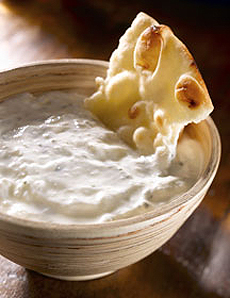Bread Glossary: A Glossary Of The Different Bread TypesPage 1: The History Of Bread Making This is Page 1 of an 9-page article. Click on the red links below to visit other pages. This glossary is protected by copyright and cannot be reproduced in whole or part. You are welcome to link to it.
|
 Naan and yogurt dip. See our review of Stonefire Naan. |
|
|
If you love good bread, you’re in luck: There’s a bread renaissance in America. Artisan bakers in many cities, and the availability of good breads in gourmet markets and by mail order, mean that one no longer has to take a trip to Europe to get a good piece of bread. The History Of Bread Making: It Started As Porridge Further experimentation led to cooking the mixture on stones that had been heated in a fire, creating the first breads, which were flat and tortilla-like. The earliest bread-making tools date to 8,000 B.C.E. Leavening, using wild yeast to make the bread rise, came later during prehistoric times. Cooking on hot stones evolved to closed ovens made of brick or clay, around 3000 B.C.E. Fueled by charcoal, they could reach temperatures of up to 480°F. The clay oven, or tandoor, was developed in the Indus Valley (in what is modern Pakistan) about the same time. The Egyptians Master Leavening, The Greeks Master Style The art of using yeast to leaven bread was mastered by the ancient Egyptians. Many cultures still enjoy forms of these early breads (see flatbread). The ancient Greeks turned bread baking into an art. They invented the front-loaded bread oven and a wide variety of doughs, loaf shapes and styles of bread to pair with specific foods. Baking became a profession, and people began to buy their bread from skilled bakers. The Romans Invent Grinding Ironically, given what we know about nutrition today, the poor ate dark whole-grain bread and the wealthy ate white bread, stripped of essential nutrients. This class separation by bread continued until the Industrial Revolution made the more elegant white bread available to everyone. |
||
Last Updated Apr 2018
© Copyright 2005-2025 Lifestyle Direct, Inc. All rights reserved. All images are copyrighted to their respective owners.